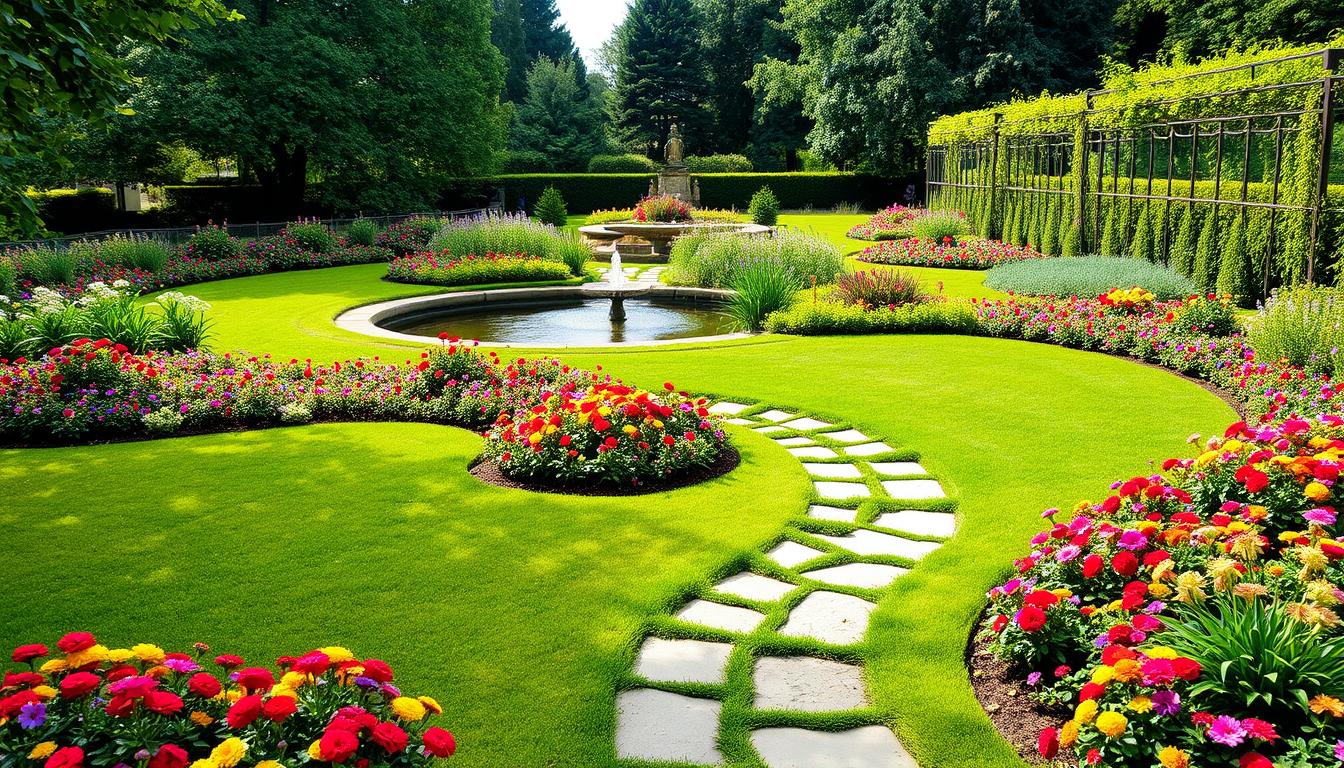Creating a functional and beautiful space for your plants doesn’t have to be overwhelming. With the right approach, you can design a setup that works for your needs and enhances your outdoor area. Whether you’re working with a small balcony or a spacious backyard, there are adaptable solutions for every space.
Steven Biggs, a horticulturist with over 25 years of experience, shares his insights on crafting effective designs. From raised beds to vertical gardening, his tips help you make the most of your area. Companion planting is another strategy that can boost plant health and yield.
There’s no one-size-fits-all solution. Your design should reflect your personal preferences and the types of plants you want to grow. Success stories, like transforming a front lawn or repurposing a driveway, show how creative planning can yield impressive results.
This guide covers everything from assessing sunlight to seasonal maintenance. Whether you’re a beginner or an experienced gardener, you’ll find practical advice to create a space you’ll love.
Key Takeaways
- Optimized designs blend form and function for better results.
- Expert tips from Steven Biggs help you plan effectively.
- Adaptable approaches work for different spaces and plant types.
- Key elements include raised beds, vertical gardening, and companion planting.
- Focus on personal needs and enjoyment for the best outcome.
- Success stories inspire creative solutions for small or unique spaces.
- A 14-section guide covers everything from sunlight to maintenance.
Introduction to Garden Layouts
Your outdoor area can become a canvas for both beauty and productivity. Modern gardening goes beyond rigid rows, offering creative freedom to design spaces that reflect your personality. As horticulturist Steven Biggs says, “Two gardeners given the same bed can create completely different layouts.”
Balancing practical needs with aesthetic preferences is key. While harvest yields are important, your setup should also bring joy and inspiration. Biggs encourages treating gardens as living canvases, where every plant contributes to the overall design.
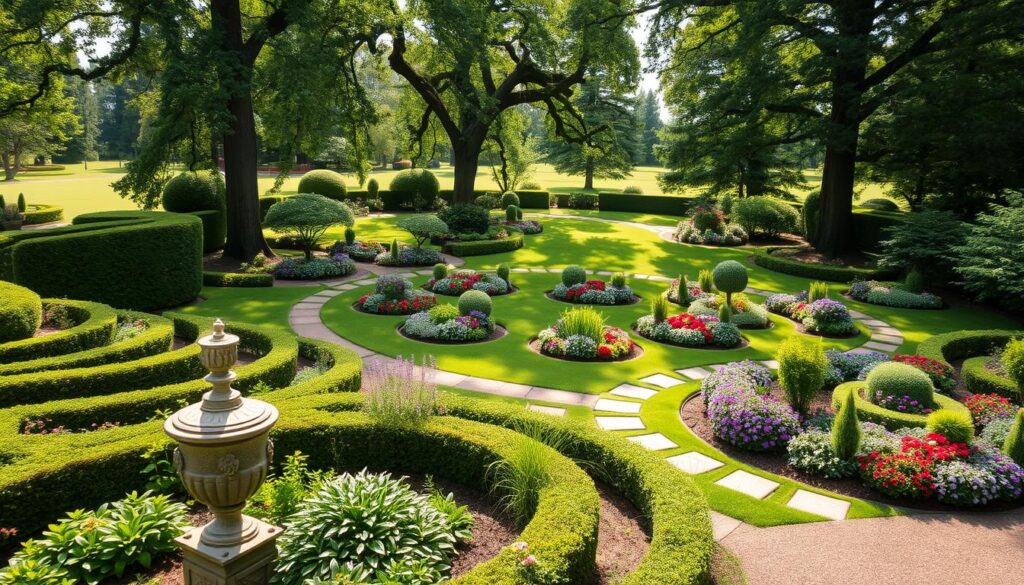
When planning your space, consider factors like sun exposure, plant compatibility, and accessibility. These elements ensure your plants thrive while making maintenance easier. Even small areas can be surprisingly productive with vertical solutions like trellises or hanging planters.
There are several layout types to explore. Formal potagers combine symmetry and functionality, while border gardens add color and texture. Container clusters are perfect for patios or balconies. Studies show that optimized layouts can increase yields by up to 40%, making thoughtful planning worthwhile.
| Layout Type | Best For | Key Features |
|---|---|---|
| Formal Potagers | Vegetable gardens | Symmetrical design, raised beds |
| Border Gardens | Ornamental plants | Colorful, layered planting |
| Container Clusters | Small spaces | Portable, versatile |
Whether you’re growing vegetables or ornamental plants, your layout should suit your needs and inspire creativity. With the right approach, even the smallest space can become a thriving, beautiful area.
Understanding Your Space
Designing a thriving outdoor space starts with understanding your environment. Whether you’re working with a small balcony or a large backyard, assessing key factors like sunlight, soil, and water will ensure your plants thrive. Let’s break down these essentials to help you make informed decisions.
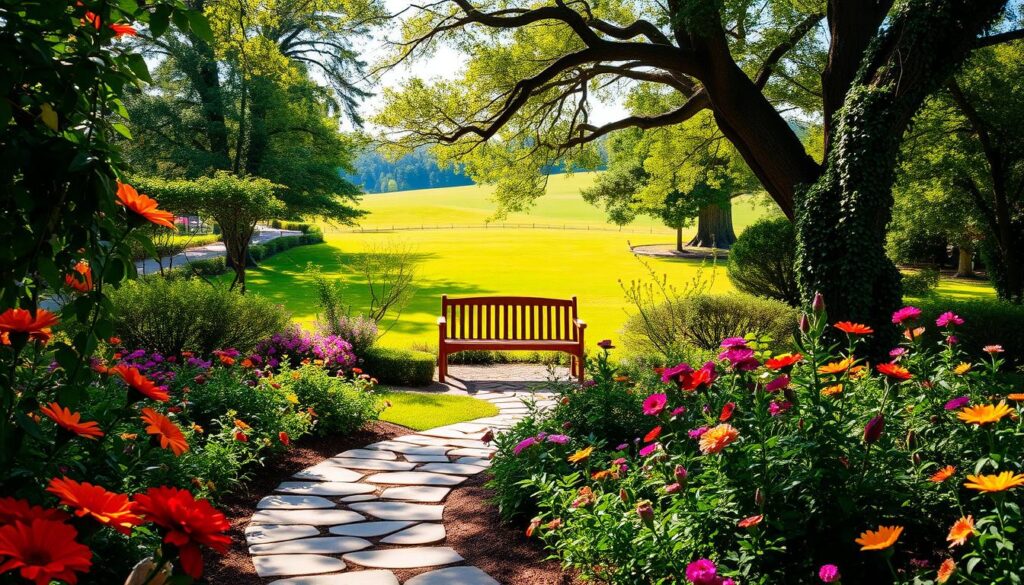
Assessing Sunlight and Shade
Sunlight is crucial for plant growth. Most vegetables need 6-8 hours of direct sunlight daily. To track sunlight patterns, use sun calculators or take time-lapse photos. This helps identify areas with full sun, partial shade, or full shade.
Some plants, like kale and spinach, thrive in areas with less than 4 hours of sunlight. Avoid planting near walnut trees, as they release chemicals that can harm other plants. A pro tip: painting fences white can boost light reflection by up to 18%.
Evaluating Soil Quality
Healthy soil is the foundation of a successful planting area. Start by testing your soil’s pH level. DIY kits are affordable, but professional analysis ($50-$100) provides more detailed insights. Most plants prefer a pH between 6.0 and 7.0.
If your soil is too acidic or alkaline, amend it with compost or lime. Regularly adding organic matter improves soil structure and nutrient content, ensuring your plants have what they need to grow.
Considering Water Access
Water is essential for plant health, but access can vary. Drip irrigation systems are efficient and conserve water, while soaker hoses are cost-effective and easy to install. Choose a solution that fits your budget and space.
For areas with limited water access, consider drought-tolerant plants or rainwater harvesting systems. Proper watering techniques ensure your plants stay hydrated without wasting resources.
| Factor | Key Considerations |
|---|---|
| Sunlight | 6-8 hours for vegetables; use reflective surfaces |
| Soil | Test pH; amend with compost or lime |
| Water | Drip irrigation vs soaker hose; drought-tolerant plants |
By understanding your space, you can create an environment where your plants flourish. Whether it’s optimizing sunlight, improving soil, or managing water access, these steps set the stage for a thriving outdoor area.
Choosing the Right Plants
Selecting the right plants can transform your outdoor space into a thriving ecosystem. Whether you’re growing vegetables or ornamental varieties, the key is to match your choices with your environment and goals. This ensures your plants not only grow well but also enhance the look of your area.
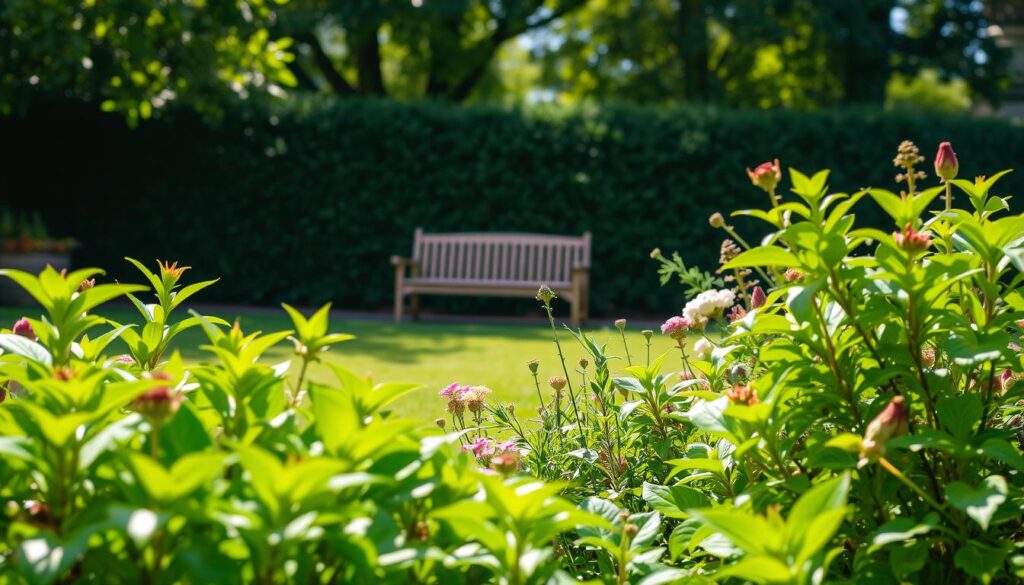
Vegetables vs. Ornamentals
When deciding between vegetables and ornamental plants, consider your priorities. Vegetables like tomatoes and carrots offer high yields, with ornamental kale producing up to 4lbs per square foot. On the other hand, decorative grasses add texture and beauty but don’t provide edible rewards.
Space-saving edibles like Rainbow chard ‘Bright Lights’ serve a dual purpose. They’re both decorative and productive, making them ideal for small areas. Avoid planting walnut-sensitive varieties like tomatoes and potatoes near walnut trees, as they can struggle to thrive.
Companion Planting Tips
Companion planting is a smart way to boost plant health and reduce pests. For example, pairing tomatoes with basil can cut pest issues by 23%. Similarly, carrots and onions grow well together, as they deter each other’s pests.
Steven Biggs, a horticulturist, recommends Malabar spinach for vertical spaces. It’s heat-tolerant and grows well in warm climates. Another pro tip: interplant marigolds every 4 feet to control nematodes naturally.
For more insights, check out the book Plant Partners, which dives deep into beneficial plant pairings. Pollinator-friendly plants like lavender and sunflowers also attract bees, boosting overall productivity.
Designing with Raised Beds
Raised beds offer a versatile solution for growing plants in limited or challenging spaces. They provide better control over soil quality, drainage, and accessibility, making them a popular choice for both beginners and experienced gardeners. Whether you’re working with a small backyard or uneven terrain, raised beds can help you create an efficient and productive planting area.
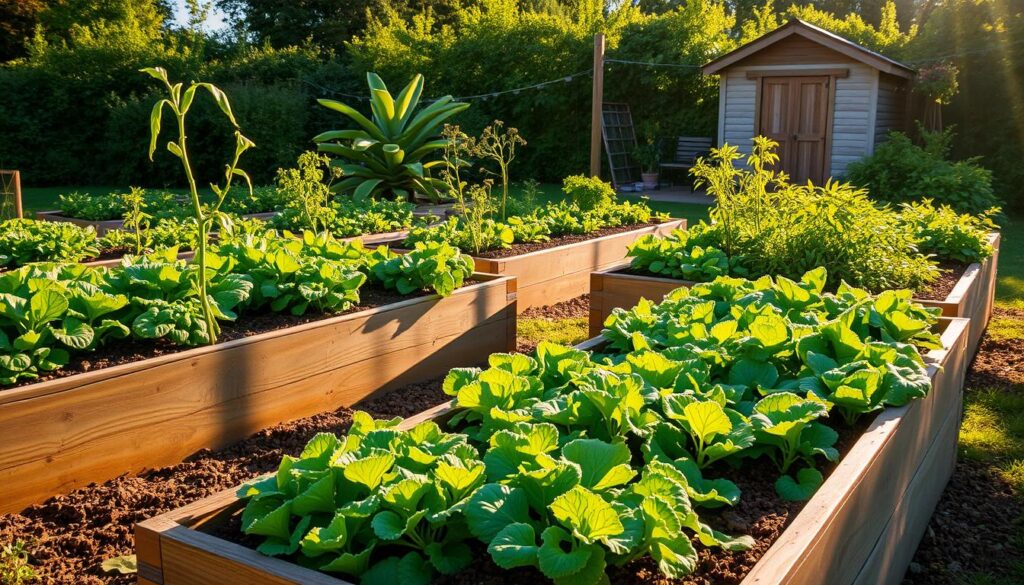
Benefits of Raised Beds
One of the main advantages of raised beds is improved soil conditions. You can fill them with high-quality soil, ensuring your plants get the nutrients they need. This is especially helpful in areas with poor native soil. Raised beds also warm up faster in the spring, giving your plants a head start.
Another benefit is reduced strain on your back. Beds built at a 24-inch height can cut bending by up to 70%, making gardening more comfortable. Additionally, raised beds deter pests like voles when lined with hardware cloth at the bottom.
How to Build Raised Beds
Building your own raised beds is easier than you might think. Start by choosing the right materials. Cedar is a durable option, costing around $150, while composite materials last longer but can cost up to $300. A 4’x8′ bed with corrugated metal sides is a popular DIY blueprint.
Soil depth is another key factor. Aim for 12 inches for root crops like carrots and 18 inches for tomatoes. Keep the width between 3-4 feet to ensure easy access from all sides. For added thermal benefits, raised beds can maintain soil temperatures 5-8°F warmer in early spring.
| Material | Cost | Longevity |
|---|---|---|
| Cedar | $150 | 10-15 years |
| Composite | $300 | 20+ years |
With these tips, you can design and build raised beds that suit your needs and enhance your planting space. Whether you’re growing vegetables or flowers, raised beds offer a practical and customizable solution.
Maximizing Small Spaces
Small spaces can still yield big results with the right strategies. Whether you’re working with a balcony, patio, or driveway, there are creative ways to make the most of your area. With vertical systems and container solutions, you can grow a variety of plants without sacrificing style or productivity.
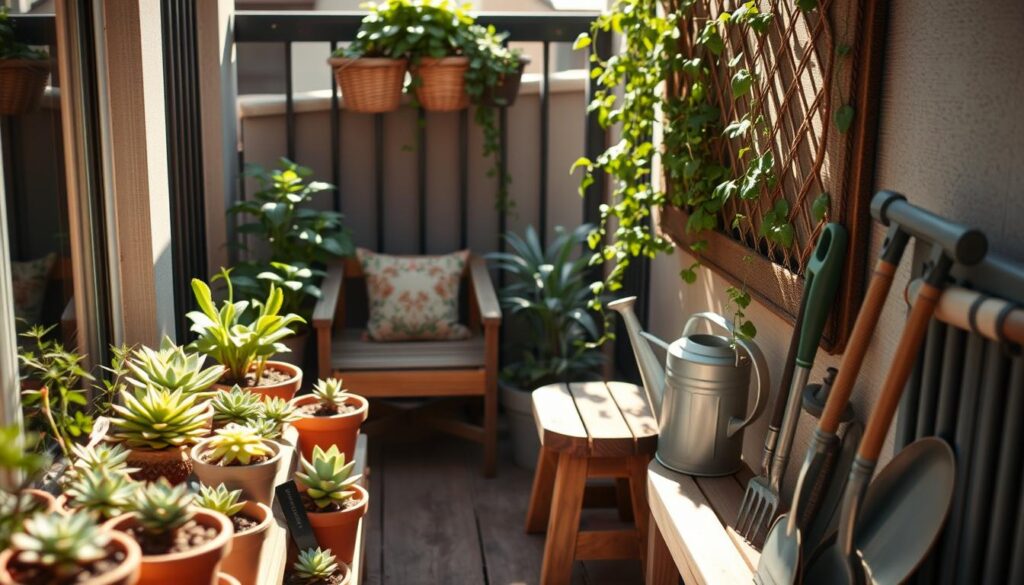
Vertical Gardening Ideas
Vertical gardening is a game-changer for small spaces. Pocket planters are a stylish option, costing around $25, while trellis netting is a budget-friendly alternative at $8 per square foot. These systems allow you to grow vining plants like tomatoes or cucumbers without taking up ground space.
For shaded areas, full-spectrum LEDs can provide the light your plants need to thrive. Steven Biggs, a horticulturist, suggests using straw bale gardens for temporary plots. This hack is perfect for renters or those with limited access to soil.
Container Gardening Tips
Containers are another excellent way to maximize small spaces. Use 5-gallon buckets for peppers and 10-gallon containers for zucchini. A 16-square-foot balcony can yield up to 45 pounds of produce with the right setup.
Pro tip: Use wheeled planters to move your containers and track sunlight throughout the day. This ensures your plants get the light they need, even in compact areas. With these strategies, you can turn any small space into a thriving garden.
Creating Functional Pathways
Pathways are more than just a way to move through your space—they’re a design element that enhances accessibility and style. Whether you’re navigating a small backyard or a sprawling outdoor area, well-planned pathways ensure ease of movement while adding visual appeal. Let’s explore how to create pathways that are both functional and beautiful.
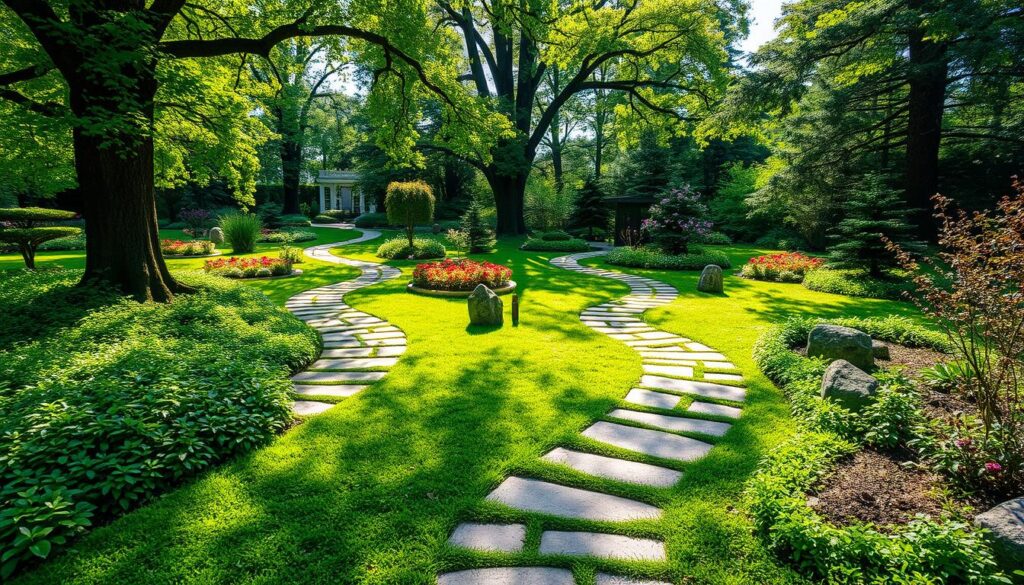
Choosing the Right Materials
Selecting the right materials is crucial for durability and aesthetics. Gravel, at $1.50 per square foot, offers a rustic look and excellent drainage. Bark mulch, costing $0.75 per square foot, is a budget-friendly option that also helps retain soil moisture.
For a more polished appearance, consider flagstone or pavers. These materials are durable and can be arranged in creative patterns. Pro tip: Plant thyme between pavers for a fragrant, low-maintenance weed control solution.
Designing for Accessibility
Accessibility should be a priority when designing pathways. Ensure a minimum width of 36 inches to accommodate wheelchairs and strollers. This ADA-compliant width makes your space inclusive and easy to navigate.
Proper drainage is also essential. Installing a French drain under flagstone pathways prevents water pooling and extends the lifespan of your materials. Solar path lights, placed every 4 feet, enhance safety and add a charming touch to your design.
By combining the right materials with thoughtful design, you can create pathways that are both practical and visually appealing. Whether you’re working with a compact area or a larger space, these tips will help you craft pathways that enhance your outdoor experience.
Incorporating Seasonal Plants
Seasonal plants bring life and variety to your outdoor space throughout the year. By rotating crops and choosing varieties suited to each season, you can enjoy fresh harvests and vibrant colors all year long. Whether you’re planting in spring or preparing for winter, understanding seasonal needs ensures your plants thrive.
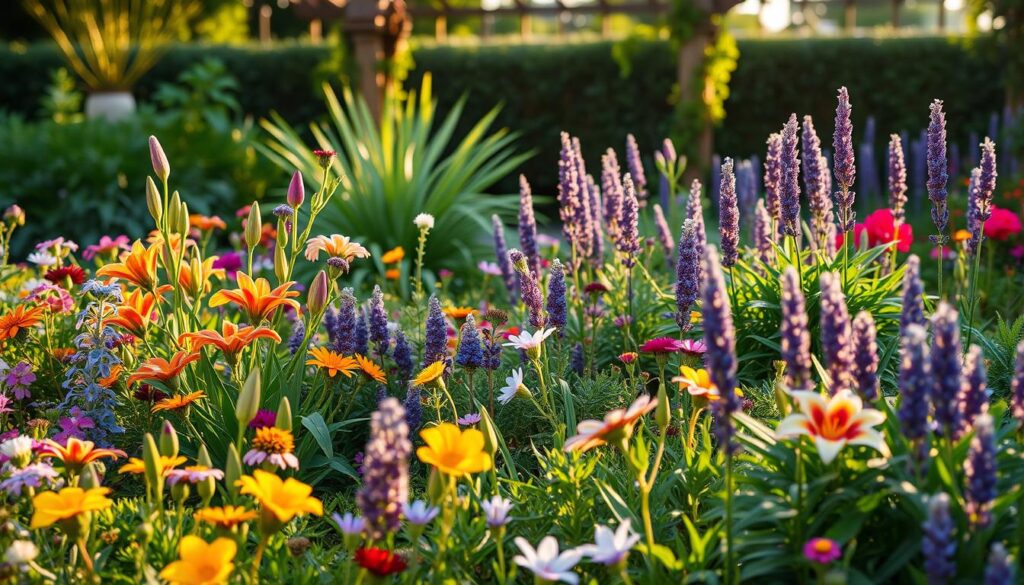
Spring and Summer Crops
Spring is the perfect time to start with quick-growing options like peas, which mature in just 55 days. Fava beans are another excellent choice, taking around 75 days to harvest. These early crops set the stage for a productive season.
As temperatures rise, summer stars like ‘Sun Gold’ tomatoes and ‘Marketmore’ cucumbers take center stage. These varieties are known for their high yields and delicious flavors. Pro tip: Use trellises to support vining plants and save space.
Fall and Winter Varieties
When cooler weather arrives, switch to frost-tolerant options like ‘Winter Density’ lettuce, which can withstand temperatures as low as 25°F. Kale is another hardy choice, surviving down to -10°F with the help of row covers.
To extend your growing season, consider using cold frames. These simple structures can add 6-8 weeks to your harvest, allowing you to enjoy fresh produce even in colder months. “Cold frames are a game-changer for winter gardening,” says Steven Biggs, a horticulturist with decades of experience.
By incorporating seasonal plants, you can create a dynamic and productive space that adapts to the changing weather. Whether you’re planting spring peas or winter kale, thoughtful planning ensures a year-round harvest.
Planning for Growth
Strategic spacing and timing are key to a productive and sustainable setup. By focusing on these elements, you can optimize your area for better results and healthier plants. Whether you’re growing vegetables or ornamental varieties, a well-thought-out approach ensures your efforts pay off.
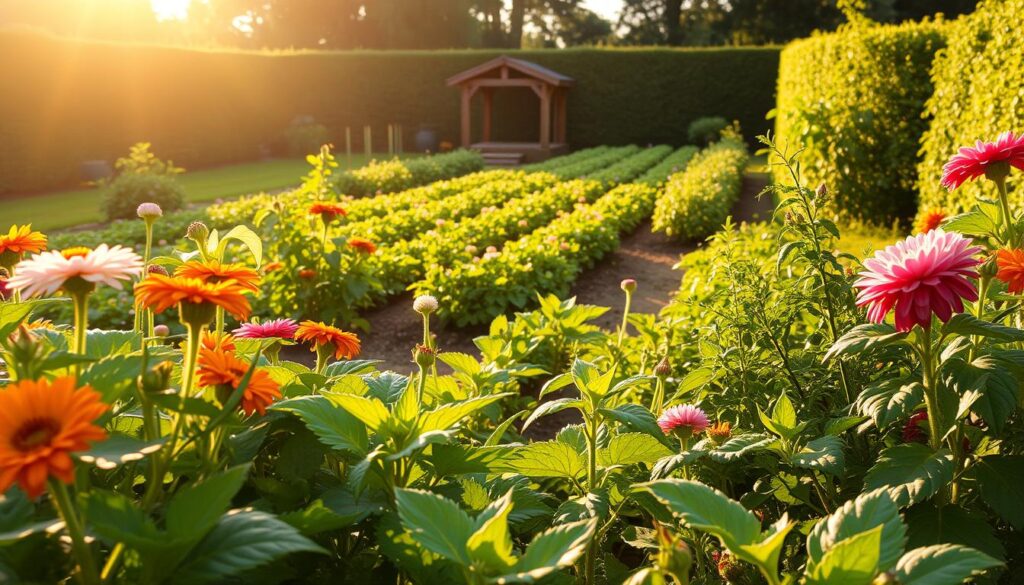
Spacing and Thinning
Proper spacing is essential for healthy plant development. Overcrowding can lead to competition for resources, reducing yields and increasing disease risk. A square foot gardening cheat sheet is a helpful tool to guide your spacing decisions.
Thinning is another critical step. For example, beets should be thinned at 14 days, while carrots need thinning at 21 days. This process ensures each plant has enough room to grow and access to nutrients.
Succession Planting Strategies
Succession planting allows you to maximize your space by rotating crops throughout the season. A simple template includes planting bush beans first, followed by beets, and then spinach. This method ensures continuous harvests and efficient use of resources.
Pro tip: Sow lettuce under corn at the tasseling stage. This takes advantage of the shade provided by taller plants, creating a microclimate for cooler-season crops.
Keeping records is also important. Digital garden planners or paper journals help track planting dates, thinning schedules, and harvest times. This ensures you stay organized and make informed decisions for future seasons.
- Spacing Guide: Use a square foot gardening cheat sheet for accuracy.
- Thinning Schedule: Thin beets at 14 days and carrots at 21 days.
- Succession Template: Rotate bush beans, beets, and spinach for continuous growth.
- Pro Tip: Plant lettuce under corn for shade and cooler conditions.
- Record Keeping: Use digital or paper journals to track progress.
Adding Aesthetic Elements
Enhancing your outdoor space with aesthetic elements can elevate its charm and functionality. A well-thought-out design not only makes your area visually appealing but also creates a welcoming atmosphere. By incorporating decorative borders, color combinations, and artistic touches, you can transform your space into a personal retreat.
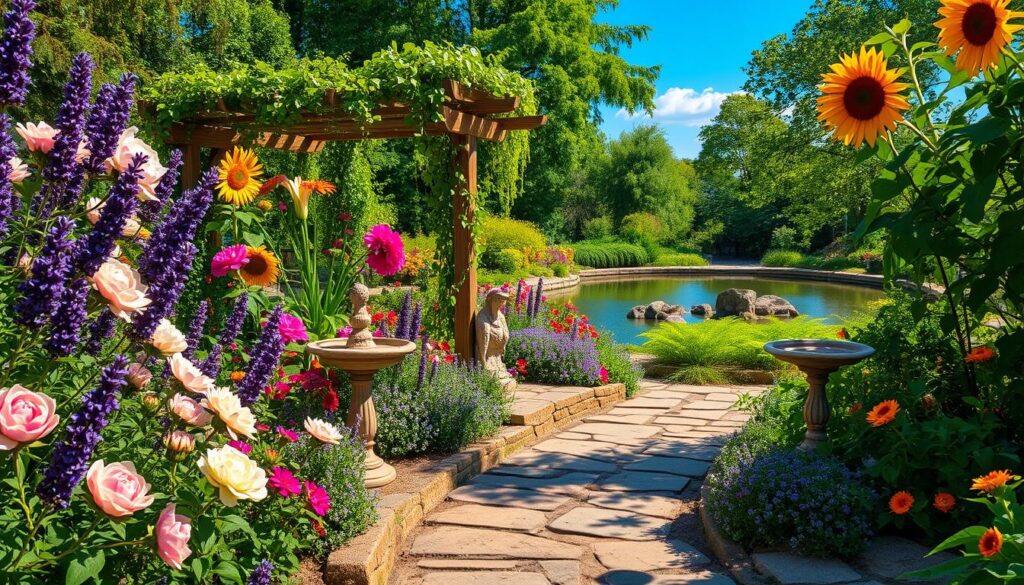
Decorative Borders
Borders are a simple yet effective way to define your space and add structure. Consider using ‘Purple Ruffles’ basil for its vibrant foliage or ‘Golden’ oregano for a pop of color. These herbs not only look stunning but also serve a practical purpose in your cooking.
For a layered effect, pair taller plants with low-growing varieties. This creates depth and makes your borders more dynamic. Pro tip: Use edging materials like stones or bricks to keep your borders neat and tidy.
Color and Texture Combinations
Color plays a significant role in setting the mood of your space. Cool tones like lavender recede, creating a calming effect, while warm tones like nasturtium pop, adding energy and vibrancy. Experiment with contrasting hues to make your area visually engaging.
Texture is equally important. Combine soft, velvety plants like lamb’s ear with feathery asparagus fern for a tactile experience. This mix adds interest and makes your space feel more alive.
- Border Plants: ‘Purple Ruffles’ basil vs ‘Golden’ oregano.
- Color Theory: Cool tones (lavender) recede, warm (nasturtium) pop.
- Texture Play: Lamb’s ear with asparagus fern.
- Artistic Elements: Hand-painted garden signs ($25 Etsy).
- Pro Tip: Use repeating container colors for cohesion.
Artistic elements like hand-painted signs can add a personal touch to your space. Repeating container colors ties everything together, creating a cohesive and polished look. With these tips, you can turn your outdoor area into a beautiful and functional retreat.
Best Garden Layout for Vegetables
Designing a productive setup for your vegetables requires thoughtful planning and creativity. The way you arrange your plants can significantly impact their growth, health, and yield. Whether you’re working with a small plot or a larger area, choosing the right approach ensures better results and easier maintenance.
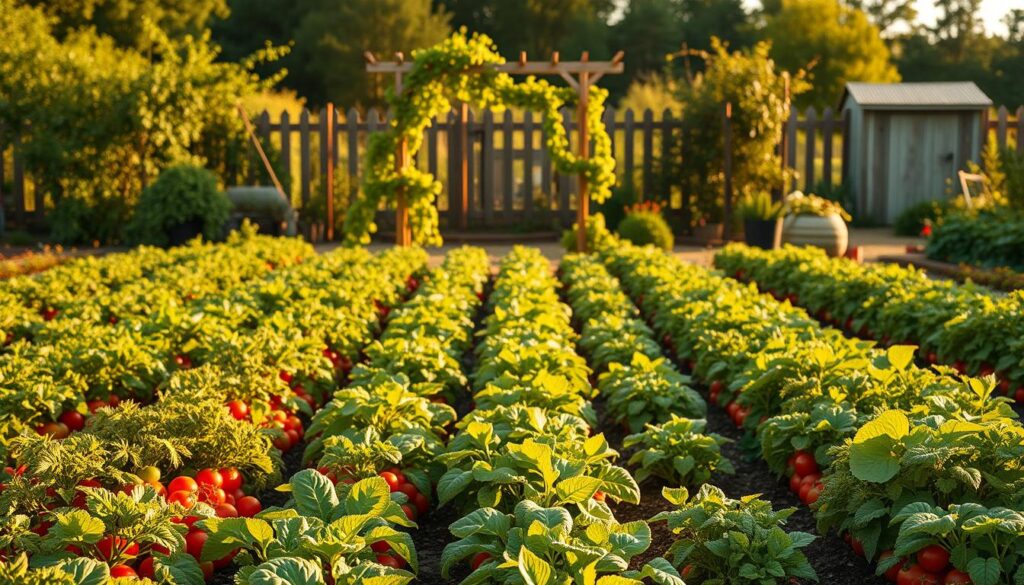
Block vs. Row Planting
Block planting is a popular method for maximizing space and yield. Studies show that this approach can produce 30% more lettuce per square foot compared to traditional rows. By grouping plants closely together, you reduce wasted space and create a microclimate that retains moisture and suppresses weeds.
Row planting, on the other hand, is ideal for larger areas and crops that need more room to spread. It’s easier to manage and allows for better air circulation, reducing the risk of disease. A triangular planting hack can increase density by 15%, making it a great option for smaller spaces.
| Planting Method | Best For | Key Benefits |
|---|---|---|
| Block Planting | Small spaces, leafy greens | Higher yield, moisture retention |
| Row Planting | Larger areas, vining plants | Better air circulation, easier maintenance |
Vertical Supports for Vining Plants
Vertical gardening is a game-changer for vining vegetables like tomatoes, cucumbers, and peas. Cattle panel arches are a sturdy option, while bamboo teepees offer a budget-friendly alternative. These systems save ground space and improve air circulation, reducing the risk of fungal diseases.
A pro tip: Use tomato cages as pea supports in spring. This repurposes existing materials and ensures your plants grow upward, not outward. For more tips on starting your planting journey, check out this beginner’s guide.
Incorporating a 4-year crop rotation cycle is another smart strategy. This prevents soil depletion and reduces pest buildup, ensuring your plants stay healthy year after year. With the right layout and supports, your vegetable setup can thrive and produce bountiful harvests.
Utilizing Companion Planting
Pairing the right plants together can create a thriving ecosystem in your outdoor area. Companion planting is a time-tested method that improves plant health, boosts yields, and naturally reduces pests. By strategically combining certain species, you can create a balanced environment where plants support each other’s growth.
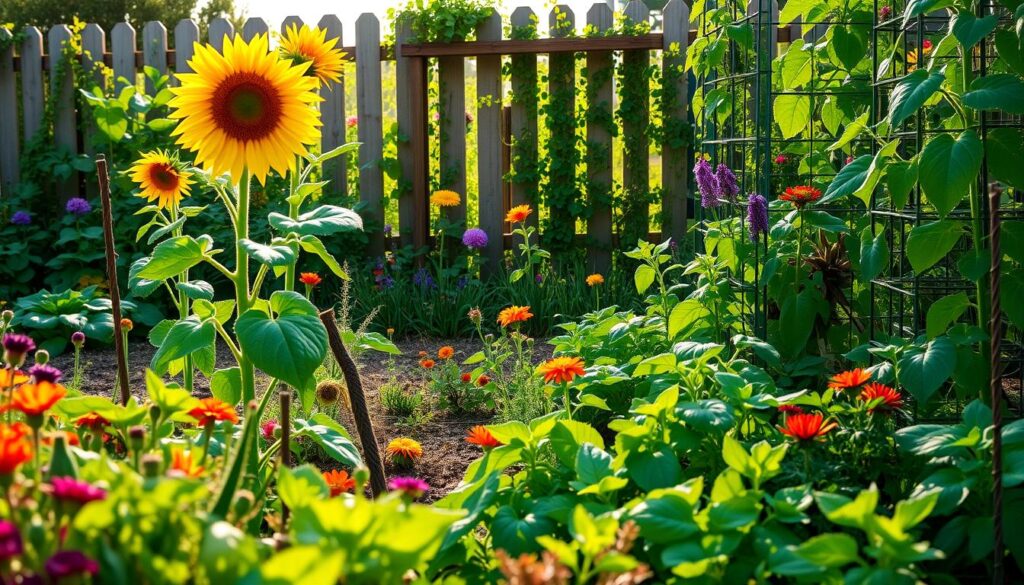
Beneficial Plant Pairings
Certain plants thrive when grown together. For example, radishes and carrots are a classic pair. Radishes grow quickly, loosening the soil for slower-growing carrots. This combination maximizes space and improves soil structure.
Another effective pairing is tomatoes and basil. Basil repels pests like aphids and whiteflies, protecting tomatoes naturally. Research from BASF shows that marigolds can control nematodes, making them a great addition to vegetable beds.
- Science-Based Pairs: Marigolds reduce nematode populations by up to 90%.
- Pollinator Magnets: Borage increases strawberry yields by 25% by attracting bees.
- Pro Tip: Plant garlic chives around rose bushes to deter aphids.
Natural Pest Control
Companion planting can also help manage pests without chemicals. Nasturtiums act as trap crops, attracting aphids away from tomatoes. This simple strategy keeps your main plants healthy and pest-free.
Another effective method is interplanting herbs like dill or cilantro. These plants attract beneficial insects like ladybugs, which feed on harmful pests. By creating a diverse planting scheme, you can maintain a natural balance in your space.
Companion planting is not just about pest control. It’s about creating a harmonious environment where plants work together to thrive. With the right combinations, you can enjoy healthier plants and a more productive area.
Maintaining Your Garden Layout
Keeping your outdoor area thriving requires consistent care and attention. Over time, small efforts can make a big difference in the health and appearance of your plants. Whether you’re a beginner or have years of experience, these tips will help you stay on top of maintenance tasks and adapt to each season.
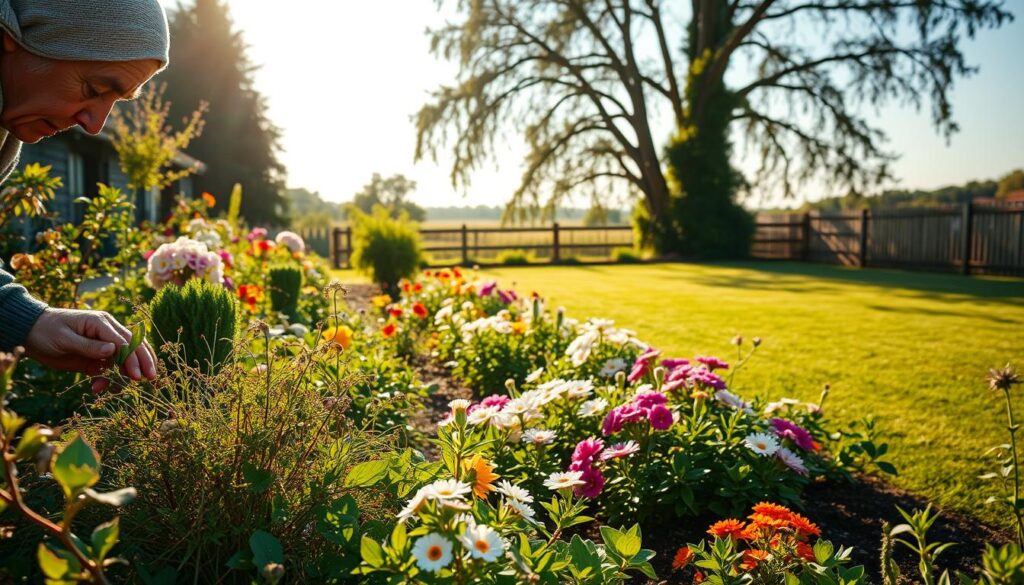
Regular Maintenance Tips
Daily and weekly tasks keep your space in top shape. Spend 15 minutes each day checking for weeds, pests, or watering needs. A weekly checklist ensures nothing gets overlooked. Here are some key tasks to include:
- Weeding: Remove weeds early to prevent them from spreading.
- Watering: Adjust based on weather conditions and plant needs.
- Pruning: Trim dead or overgrown branches to encourage healthy growth.
Pro tip: Sharpen your pruners every 6 months to ensure clean cuts and reduce plant stress.
Seasonal Adjustments
Each season brings unique challenges and opportunities. In spring, focus on soil preparation and planting. Summer requires consistent watering and pest control. Fall is ideal for harvesting and planting cool-weather crops. Winter is the perfect time for tool maintenance and planning for the next season.
- Soil Refresh: Add compost annually to replenish nutrients.
- Tool Organization: Use winter to clean and organize your tools.
- Record Keeping: Track planting dates and maintenance tasks using a Google Sheets template.
By staying proactive and adapting to each season, you can ensure your garden remains healthy and productive year-round.
Conclusion
Crafting a thriving outdoor setup is a journey of discovery and creativity. By focusing on sun optimization, utilizing vertical space, and practicing succession planting, you can maximize your area’s potential. Remember, your perfect way of arranging your plants will evolve over time as you experiment and learn.
For more inspiration, check out the book Kitchen Garden Revival. It’s packed with ideas to help you design a vegetable garden that’s both productive and beautiful. A helpful tip: photograph your garden layout seasonally to track changes and improvements.
Ready to share your designs? Tag @gardenaryco on social media to showcase your creativity and connect with fellow enthusiasts. Your space is unique—let it reflect your personality and passion!

